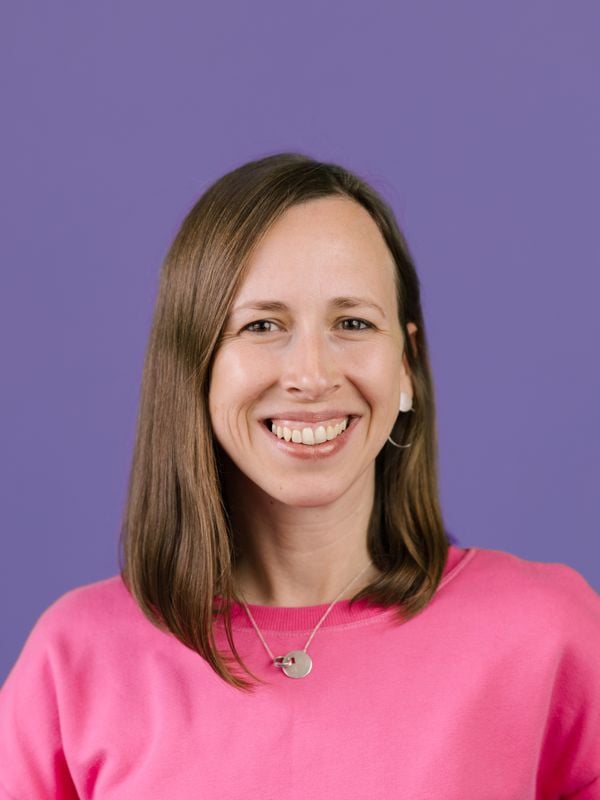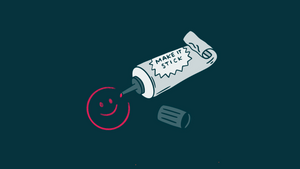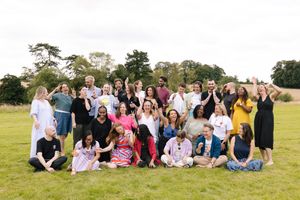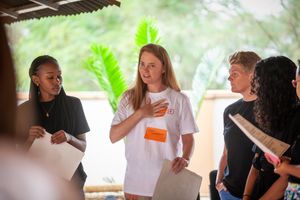
The 5 principles which helped us build a tech and innovation pipeline during a global pandemic
Do you remember how you felt in March 2020 — the month the UK went into a national lockdown? The month when the words “global pandemic” really hit home?
I do. I remember being struck by an overwhelming sense of panic.
But I was also incredibly lucky to be part of a team funded by UK Aid who within 24 hours of the WHO’s announcement of a global pandemic, launched COVIDaction: an initiative to source and scale innovations from across the globe responding to the pandemic. By offering funding and venture support to make them happen, we brought together a team of multidisciplinary experts who hoped to uncover the next generation of innovations to solve the pandemic and other global challenges across four thematic areas: local production and solutions, data, resilient health systems, and global access to oxygen.
I’ve learned very soon after the launch that innovation often lies on the side of discomfort — in the midst of ambiguity, uncertainty, tension and risk. This was the first time we set out to do this type of work with our wonderful partners (Results for Development, IMC Worldwide, Global Disability Innovation Hub, UCL’s Institute of Healthcare Engineering), whilst moving to work from home, dealing with health and family concerns. Everyone had questions and all I craved was answers.

In this type of uncertain situation, ideally I should have been at my most adaptive, but instead, I froze. My body entered survival mode, my mind paralysed by the uncertainty of what lay ahead. This was a significant departure from my usual energetic-getting-things-done self.
Something physical happens when we’re stressed. When triggered by threats, blood is pulled away from the logical, rational part of our brain (known as the prefrontal cortex) towards our limbic system. This is the oldest, reptilian part of our brain, which is trying to keep us safe by telling us what we need to do next: fight, flight or freeze. This is why it can be difficult to make good decisions during times of uncertainty — our brain simply doesn’t like it. It’s safe to say that at the beginning of COVIDaction I was caught in a ‘limbic freeze’. But at Brink, we’re intentional in managing uncertainty so that we can thaw out of that freeze and pull together with our brilliant partners and funders.
💨 Fast-forward 20 months later
FCDO-funded COVIDaction has invested £2.4 million of grant funding into 36 innovations, each contributing to remarkable responses to the pandemic, from using banana tree trunk fibre for producing safe birthing kits to new healthcare models in Bangladesh and global epidemiological data models.

We have also prototyped new global models of collaboration, convening product innovators, academics and engineers to clear the path to market for essential products like oxygen concentrators, and the public sector to pave the way with regulation and financing. We’ve also designed inclusive models for surfacing innovation, working with local organisations to surface offline communities of local grassroots producers, to engage with those who were not connected to the internet.
Our approach allowed us to step into the unknown. And I want to share with you the five principles which underpinned it:

1. A moral purpose anchors you
We acknowledged early on that you can’t always be in control of everything. But you can always ground yourself in why you are doing something. During COVIDaction, this boiled down to the project’s moral purpose.
COVIDaction was created to explore how the pandemic might become the driving force for long-term resilience and the role of technology in this change.
Everyone could see the long-term impact of this project. It touched the greener recovery, strengthened health systems, access to oxygen, informed decision making. This was our anchor for the duration of the project and acted as our guiding principle behind all our strategies and investments.
We cared deeply about constantly having a shared way forward and iterated our direction as new priorities emerged from the pandemic (more on this below).
2. Focus on questions over answers
At Brink we don’t seek answers, we ask questions — as there’s always more to learn.
This is because we’ve found that questions open up a world of possibilities and stimulate curiosity, imagination, aligning everyone to the same big goal. Meanwhile, answers often only have temporary value, as they may only be correct under particular circumstances.
During COVIDaction we asked:

Every two months we paused to take stock. We asked ourselves ‘what have we learned?’ and ‘are these still the right questions to ask?’ instead of ‘have we found the answer to these big questions?’
For some questions, certainty may never be reached and that’s OK.
3. It’s all about the networks
Finding solutions to some of the biggest questions of our time, like global access to oxygen or the equitable distribution of vaccines, requires collaboration.
During COVIDaction we recognised this work is bigger than us and that to create change we would need to build networks and connect with the wider ecosystem, to pool our collective knowledge and resources.
This looks like:
- Applying networked learning to inform the next generation of oxygen concentrators for low-resource settings, engaging with 100+ experts through a global series of meetups and interviews;
- Supporting our innovator from Nepal to build a web of production to have better insight into existing PPE demand and production capacity;
- Bringing together communities of local producers not connected to the internet to learn from each other.
We’ve learned together with our networks and explored those big questions. And this has made the journey much more enjoyable and helped bring clarity.
4. Really listen
We’ve built the networks, but then we also listened closely to what was emerging from the work of our partners and collaborators. We then moved resources around based on their feedback and requests for support. For example, many of our data innovators pivoted to respond to the emerging needs of the pandemic, such as the equitable distribution of vaccines. We’ve followed them on their journey, and changed our focus to exploring how data might be used for the equitable distribution of vaccines?
You can’t learn if you don’t listen. When it comes to creating positive change, if feedback isn’t genuinely listened to and incorporated into your strategy you’ll simply miss out on driving meaningful change.
5. Frameworks provide autonomy
Establishing a process across multiple environments doesn’t work if it’s enforced rigidly. Yes it can provide a good outline of how to get from ‘A’ to ‘B’, but there always needs to be flexibility in place, as no situation or team is the same. People and organisations need to be given their own autonomy and sense of independence, so they feel empowered to not only do the job well, but make suggestions on how it can be improved.
During COVIDaction Brink created an intentional simple framework to give us the handrails to help us answer those big questions. We called it SETS. We set out to Scan the globe for promising innovation, Evaluate what we find, Team up with experts for venture support, and Share what we find as a global good. We’ve brought world-class experts to lead each area, but made sure to use the SETS framework as a guide, not dogma, with space to dial elements up or down depending on what experts believed was suited to each — vastly different — area.
We didn’t make the calls, we just provided a framework for the big questions shared above to be answered.
The beauty about this model is that once you set it up, it will continue to have a life of its own.
Once the entire team embodied this framework, it helped us ensure our networks could also leverage it to continue to answer our shared big questions, beyond our direct support. For example, we partnered with pan-African organisation AfriLabs to lead a local innovation scouting process. We wanted to explore together the big question ‘How do you connect global resources to local communities to support recovery in a time of crisis?’
AfriLabs went on and activated their own network across 3 African cities to help scout local innovation, listened to the constraints of their network when engaging with these communities, and set up a framework through which their networks were able to deliver direct support to these innovators. And the virtuous circle continued with their networks taking on this big question, making it theirs, tapping into their own networks and so on.
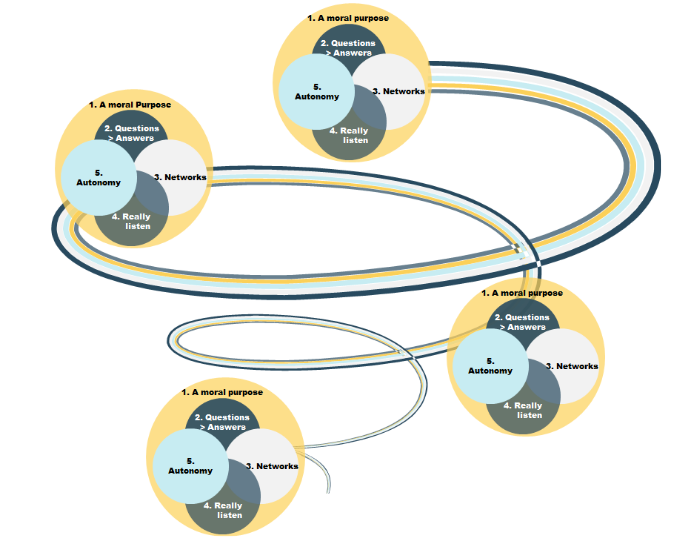
In March 2020, we had no idea what would emerge through our open calls for innovation and if we would even take up a role in the global response to the COVID-19.
Even though today we know so much more than last year, we are still innovating in a space of deep uncertainty. But we now know that our 5 practices will have our back! And that they will also support our networks (and their networks) to work and learn together about the potential of technology in the long-term response to the pandemic crisis.
This exploration of the unknown would have simply not existed if it were not for our visionary FCDO colleagues who trusted us and had our back through the many iterations of this work as new information became available during the pandemic. These practices essentially emerged through the strategic brains of Magdalena Banasiak, Lea Simpson and Tamara Giltsoff coming together on those dark March 2020 Thursday mornings. And they have the fingerprints of all the wonderful theme leads, team members and partners all over them.
To find out more about COVIDaction, follow them on Twitter or read their blog.
